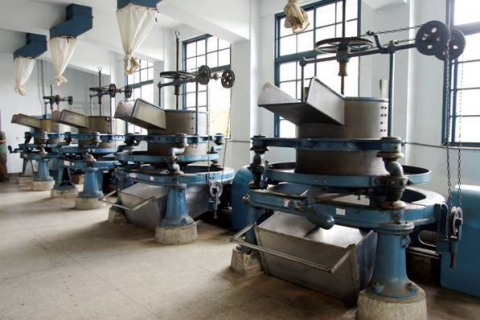
Jackson's Tea Leaf Rolling Machine (40's)
During the Japanese colonial era, the Daxi Tea Factory imported six Jackson's 36 inch rolling machines. The wheels at the top and the bottom rotate to roll the tea leaves, deforming the cells of the leaves and causing the extracted juice to cling to the leaf surface, which facilitates the release of polyphenols upon brewing.
Rotorvane
Churning tea leaves generates friction, which activates the cells along the leaf margin, facilitating the entering of air into the mesophyll cells, and thereby accelerating the process of oxidation. Turning and stirring the tea leaves also helps the leaves "desiccate" evenly. (To desiccate means to dehydrate)
Tea Leaf Roaster
The purpose of tea leaf roasting is to deactivate the enzyme polyphenol oxidase with heat, and arrest the oxidation process so that the grassy smell of the fresh leaf may be removed while the aromas and flavors peculiar to the oxidized tea leaf are retained. Meanwhile, as the leaf loses a large amount of moisture during fixing, the leaf desiccates, facilitating the following rolling and drying processes.
Leaf Steaming Machine
The main body of the steaming machine is a cylindrical drum with mesh base. The center is designed with porous steam holes. Fixing is processed by using steam at 100 degrees centigrade to cook the tea leaf and deactivate the enzyme polyphenol oxidase.
Roller
The roller is filled with tea leaves, and as the machine churns, the cells and the cell walls of the tea leaves rupture when pressure is applied. While the tea leaf curls and tightens, some of the juice emerges and clings to the surface, allowing polyphenols to be released within a short time upon brewing, making the tea savoury and mellow.
Roll Breaker
The roll breaker is used following the rolling process to loosen the masses formed due to the leaves being rolled. The process helps to loosen leaves from the masses to facilitate drying and other subsequent procedures.
Vane Cylinder
Cut the tea leaves that are too thick or coarse into the appropriate size to facilitate subsequent grading and other procedures.
Stalk Extractor
Vibration and physical properties are employed to extract the stalk from the leaves, improving the quality of the tea.
Mesh Sifter
The mesh sifter is utilized to extract O.P. B. grade leaves from F. D. grade leaves (fannings and dust) so that the tea leaves are of the same size and consistent quality is maintained.
A Type Dryer
Rolled tea leaf is blown dry with heated air in the A type dryer to reduce the leaves' moisture to 5 percent or lower, which promotes preservability and facilitates traveling. In general, to achieve consistently dried leaves, the drying procedure is often adopted twice. The first drying reduces the leaves' moisture to 20 to 30 percent. Then the leaves are taken out to rehydrate before being dried the second time.
Barrel Ball Forming Machine
With an appearance similar to a ready-mixed concrete mixer, the "olive barrel ball forming machine" was a product created in the 70's as Taiwan's tea industry welcomed "semi-mechanization." The barrel ball (or ball-shaped finished tea pellet) that the machine produced became a sensation in Taiwan. The ball-shaped tea pellet looks fluffy. It is fluffier when compared with a ball-shaped oolong tea pellet, but tighter than the spear-shaped pouchong tea pellet.


